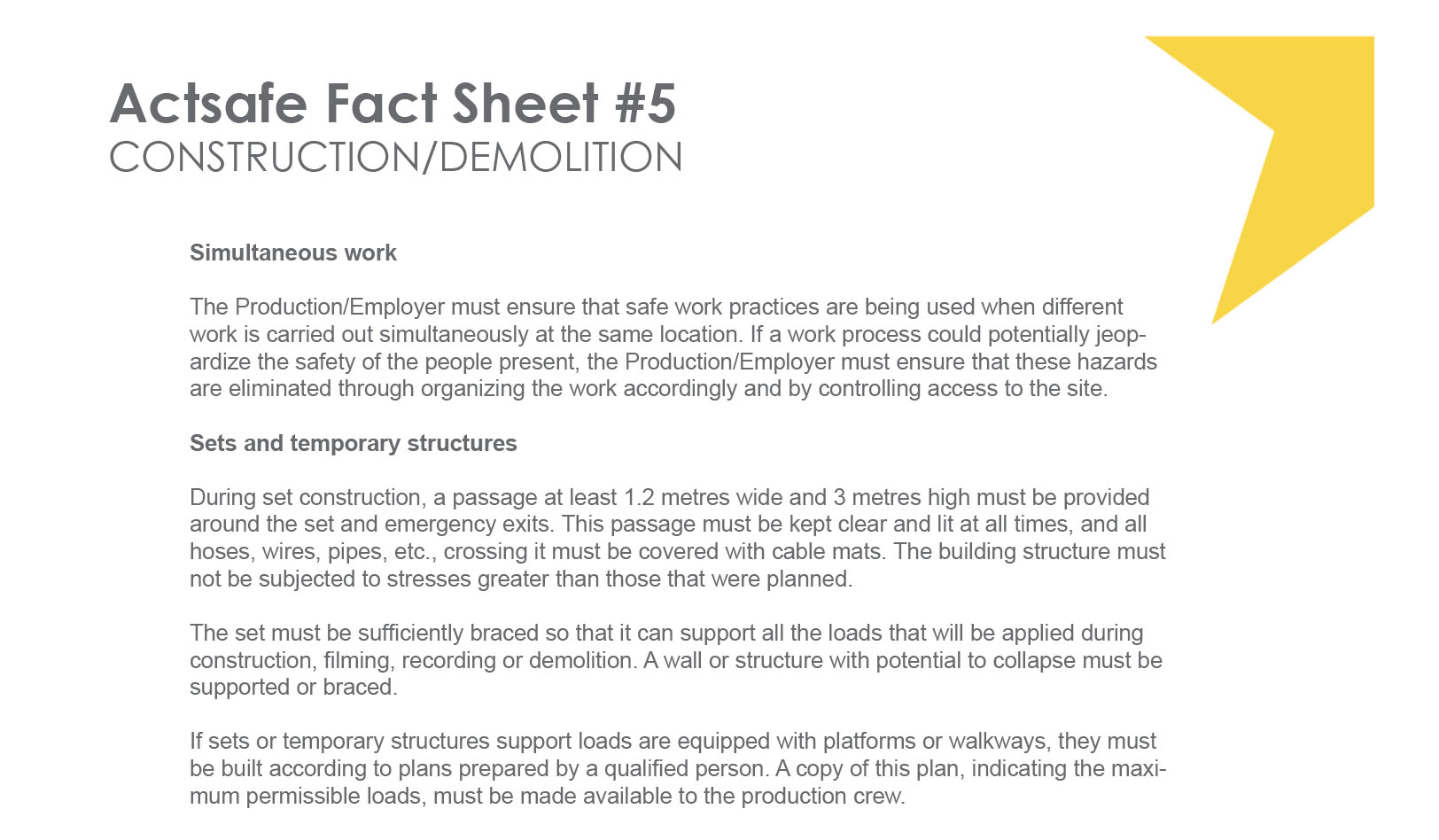To read the full document, and to print, click here (196 KB).
SIMULTANEOUS WORK
The Production/Employer must ensure that safe work practices are being used when different work is carried out simultaneously at the same location. If a work process could potentially jeopardize the safety of the people present, the Production/Employer must ensure that these hazards
are eliminated through organizing the work accordingly and by controlling access to the site.
SETS AND TEMPORARY STRUCTURES
During set construction, a passage at least 1.2 metres wide and 3 metres high must be provided around the set and emergency exits. This passage must be kept clear and lit at all times, and all hoses, wires, pipes, etc., crossing it must be covered with cable mats. The building structure must not be subjected to stresses greater than those that were planned.
The set must be sufficiently braced so that it can support all the loads that will be applied during construction, filming, recording or demolition. A wall or structure with potential to collapse must be supported or braced.
If sets or temporary structures support loads are equipped with platforms or walkways, they must be built according to plans prepared by a qualified person. A copy of this plan, indicating the maximum permissible loads, must be made available to the production crew.
When platforms, walkways or structures support loads greater than 194 kg/m2, or when the spacing between the structural components is 600 mm or more, the plans must be signed by an engineer and bear his seal.
Work areas must be kept in order; materials must be stored safely; tools must be kept in good condition; and demolition waste must be removed. Protruding nails must be removed or bent back, unless the material is piled or placed in a container to be transported outside the work area. During dismantling of a set, nails protruding from a piece of reusable wood must be immediately removed.
When in use, jacks or hoists must be installed on a solid foundation, aligned with the load to be lifted, and equipped with a stopping mechanism at the screw’s end of stroke or an end-of-stroke indicator.
HAND TOOLS
Hand tools must be:
(a) appropriate for the work to be done;
(b) used only for the purposes for which they were designed;
(c) replaced or repaired if they are defective;
(d) stored so that they do not fall on or block work or traffic areas.
PORTABLE ELECTRIC TOOLS
A machine in operation must never be left unsupervised.
Before leaving the premises, the power must be shut off and all moving parts must have stopped.
Portable electric tools must be:
(a) powered by a wire equipped with a third conductor for grounding; or
(b) equipped with double insulation; or
(c) connected to a circuit equipped with a ground fault circuit interrupter
The controls for portable electric or pneumatic tools must be:
(a) located in such a way as to reduce as much as possible the risk of accidental start-up;
(b) designed in such a way as to automatically cut off the power or air supply when the operator releases them.
Electrical wires and pressurized flexible hoses must be hung or protected to prevent them from being damaged.
Before portable tools are used, all protectors or protective devices must be installed. Cutting tools must be kept in good condition, be properly sharpened, and be equipped with a blade guard or protectors.
Automatically loaded tools such as staple guns or gun nailers must be equipped with a mechanism that prevents operation before contact with the work surface. The triggers must not be deactivated.
Equipment such as saw benches, sanders, routers, etc., must be equipped with a dust collector at the dust source.
When dust, vapours or toxic mists are in the air, the producer/supervisor must make sure that the workers have respiratory protective equipment supplied by the employer as required in WorkSafeBC regulation Part 5 Chemical Agents and Biological Agents.
PERSONAL PROTECTIVE EQUIPMENT
The members of the production crew and visitors must wear CSA approved safety hats and boots when there is a risk of injury from falling objects, blows, electric shock, the presence of fused metal or hot or corrosive liquids, etc.
The employer must supply workers with hearing protectors when the noise level exceeds the permissible limit (WorkSafeBC regulation Part 7 division 1: Noise Exposure). The producer, or his representative, must make sure that anyone exposed to these noise levels wear the appropriate equipment. Protection is considered necessary when it becomes difficult to hear a person speaking at a distance of 30 to 60 cm.
Any person doing construction or demolition work must wear protective gloves and safety glasses or a face shield.
When working with or near electrical tools or machines, close-fitting clothing must be worn and ties and jewelry must be removed.
ADDITIONAL RESOURCES:
Disposal and recycling, see Reel Green BC
Painting and staining work, refer to the following Actsafe documents, available at actsafe.ca.
Paint Safety Guideline #1: WHMIS Requirements
Paint Safety Guideline #2: Substitution Choices for Common Products
Paint Safety Guideline #3: Ventilation
Paint Safety Guideline #4: Paint Spraying Systems
Paint Safety Guideline #5: Personal Protective Equipment (PPE)
Paint Safety Guideline #6: Storing Paint Products
Paint Safety Guideline #7: Disposing of Paint Products
Actsafe Motion Picture Safety Bulletins available here.
#39 – Foam(ed) Plastics in Set and Prop Construction (Motion Picture)
#10 – Foam(ed) Plastics in Set and Prop Construction (Performing Arts)
To read the full document, and to print, click here (196 KB).



Share Now: